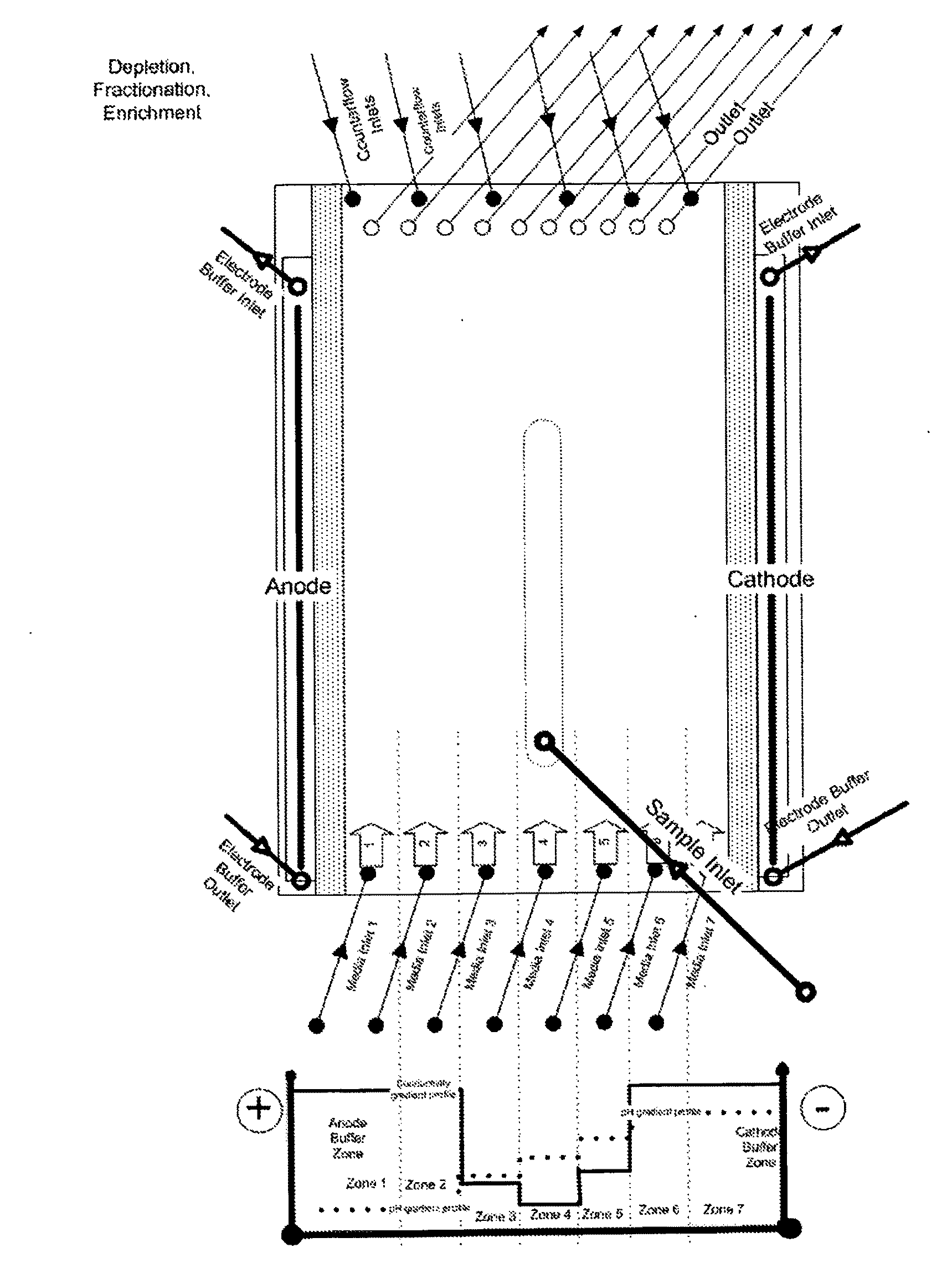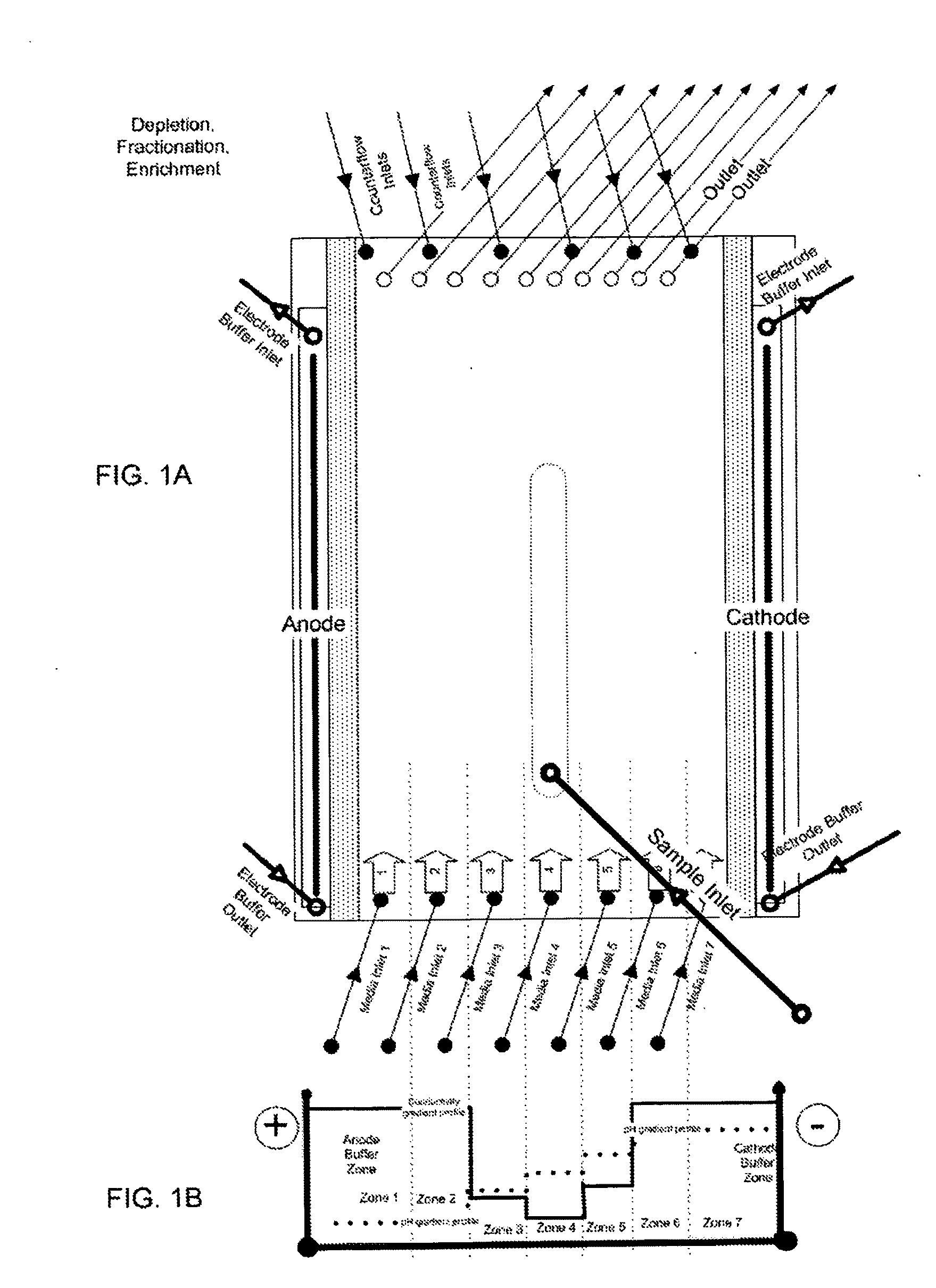Method and device for separation and depletion of certain proteins and particles using electrophoresis
a technology of electrophoresis and proteins, applied in the direction of mass spectrometers, peptides, liquid/fluent solid measurements, etc., can solve the problems of not preventing the use of existing methods (or the combination of several existing technologies), the composition of applications that do not disclose the composition of separation media, and the difficulty of identification of the problem
- Summary
- Abstract
- Description
- Claims
- Application Information
AI Technical Summary
Benefits of technology
Problems solved by technology
Method used
Image
Examples
example 1
Separation of Human Plasma According to a DFE Protocol
[0248]The example demonstrates the separation of a high abundant protein (human serum albumin, HSA) from a human plasma sample using the gel-free, support matrix free, or carrier-free FFE electrophoresis method using a DFE protocol and an apparatus suitable to carry out said method. Native human plasma is diluted 1:10 with the medium of medium inlet 4 of an apparatus shown in FIG. 1A and injected or introduced via sample inlet 4 into the separation area at a sample load rate of 5 ml / h.
[0249]The following media were introduced into the apparatus:
Medium inlets 1 and 2: 100 mM sulfuric acid+10% glycerol (pH 1.30)
Medium inlet 3: 200 mM 2-amino-butyric acid, 100 mM gluconic acid, 50 mM pyridinethanesulfonic acid (PESS), 30 mM glycylglycine, 10% glycerol (pH 3.39)
Medium inlet 4: 30 mM MES, 100 mM glycylglycine, and 10% glycerol (pH 4.92)
Medium inlet 5: 200 mM MOPSO, 20 mM MES, 100 mM β-alanine, 50 mM BISTRIS, and 10% glycerol, (pH 6.06...
example 2
Separation of Human Plasma According to a DSE Protocol
[0257]The example demonstrates the separation of a high abundant protein (human serum albumin, HSA) from a human plasma sample using the gel-free, support matrix free, or carrier-free FFE electrophoresis method using a DSE protocol and an apparatus suitable to carry out said method. Native human plasma is diluted 1:10 with the medium of medium inlet 4 of an apparatus shown in FIG. 4 and injected or introduced via sample inlet 4 into the separation area at a sample load rate of 5 ml / h.
[0258]The following media were introduced into the apparatus:
Medium inlet 1: 100 mM sulfuric acid; 10% glycerol
Medium inlet 2: 100 mM sulfuric acid; 10% glycerol
Medium inlet 3: 25% BD FFE Separation Buffer 1+10% glycerol
Medium inlet 4: 30 mM MES; 100 mM glygly; 14% BD FFE Separation Buffer 2; 10% glycerol
Medium inlet 5: 25% BD FFE Separation Buffer 2+10% glycerol, (pH 6.94)
Medium inlet 6: 150 mM NaOH+50 mM Ethanolamine, 10% glycerol
Medium inlet 7: 15...
example 3
Parallel DFE Separation of Analytes from Two Samples
[0265]The Example demonstrates the simultaneous separation of high abundant protein (human serum albumin, HSA) from two human plasma samples using the FFE electrophoresis method of the present invention using a modified parallel DFE protocol and an apparatus suitable to carry out said method. The protocol employed for this Example employed, starting from the anode to the cathode, the following media: an anodic stabilization medium, a first separation zone comprising a first pH function and a first pH separation plateau, an inter-electrode stabilizing medium which acts also as a focus medium adjacent to the pH separation plateaus of separation zone 1 and 2, a second separation zone comprising a pH separation plateau and a second pH function and a cathodic stabilization medium.
[0266]The first native human plasma sample was diluted 1:10 with the medium of medium inlet 2 and injected or introduced via sample inlet positioned near media...
PUM
| Property | Measurement | Unit |
|---|---|---|
| pH | aaaaa | aaaaa |
| pH | aaaaa | aaaaa |
| pH | aaaaa | aaaaa |
Abstract
Description
Claims
Application Information
 Login to View More
Login to View More - R&D
- Intellectual Property
- Life Sciences
- Materials
- Tech Scout
- Unparalleled Data Quality
- Higher Quality Content
- 60% Fewer Hallucinations
Browse by: Latest US Patents, China's latest patents, Technical Efficacy Thesaurus, Application Domain, Technology Topic, Popular Technical Reports.
© 2025 PatSnap. All rights reserved.Legal|Privacy policy|Modern Slavery Act Transparency Statement|Sitemap|About US| Contact US: help@patsnap.com



